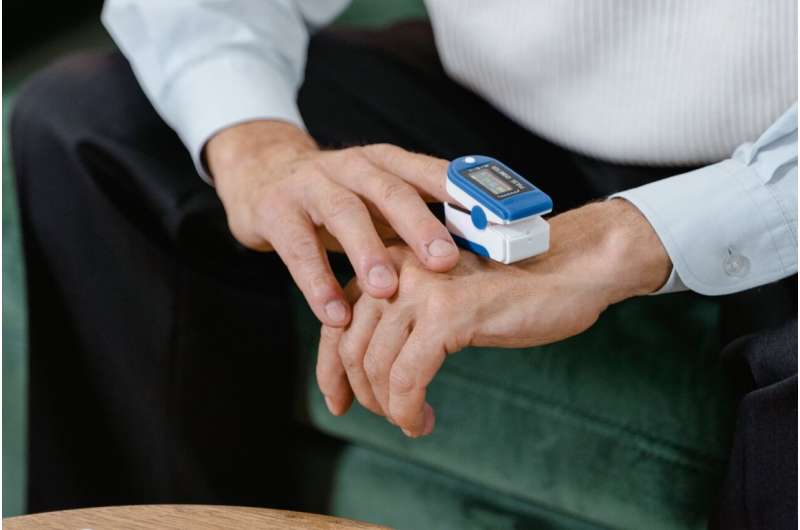This article has been reviewed according to Science X's editorial process and policies. Editors have highlighted the following attributes while ensuring the content's credibility:
fact-checked
trusted source
proofread
Living with COPD

November is National COPD Awareness Month, which makes this a good time to learn more about living with chronic obstructive pulmonary disease, or COPD.
COPD is a leading cause of disability and death in the U.S., according to the American Lung Association. More than 12.5 million people in the U.S. have been diagnosed with COPD, but millions more may have the disease without knowing it.
COPD is a chronic inflammatory lung disease caused by long-term exposure to irritating gases or particulate matter, most often from cigarette smoke. People with COPD are at increased risk of developing respiratory infections, heart disease, lung cancer, pulmonary hypertension and depression. Also, if you have a chronic lung disease such as COPD, you may be at greater risk of severe illness and complications from COVID-19.
Factors that can increase your risk of COPD include exposure to tobacco smoke, including secondhand smoke; asthma; occupational exposure to dust and chemicals; exposure to fumes from burning fuel; and genetics.
Symptoms
Symptoms of COPD often don't appear until significant lung damage has occurred, and they usually worsen over time, particularly if cigarette smoke exposure continues.
Signs and symptoms of COPD can include:
- Shortness of breath.
- Wheezing.
- Chest tightness.
- Chronic cough that may produce clear, white, yellow or green mucus.
- Frequent respiratory infections.
- Lack of energy.
- Unintended weight loss.
- Swelling in the ankles, feet or legs.
Treatment
If you've been diagnosed with COPD and you smoke, it is important that you quit. Most cases of COPD in the U.S. are directedly related to long-term cigarette smoking. Stopping smoking can prevent COPD from worsening and reducing your ability to breathe.
Many people with COPD have mild forms of the disease for which little therapy is needed other than quitting smoking. Even for more advanced stages of the disease, effective therapy is available that can control symptoms, slow progression, reduce your risk of complications and exacerbations, and improve your ability to lead an active life.
Treatment for COPD can include medications, lung therapies, in-home noninvasive ventilation therapy, managing exacerbations and surgery.
Coping
Living with COPD can be a challenge—especially as it becomes harder to catch your breath. You may have to give up some activities you previously enjoyed. Your family and friends may have difficulty adjusting to some of the changes.
It can help to share your fears and feelings with your family, friends and health care team. You also may want to consider joining a support group for people with COPD, and you may benefit from counseling or medication if you feel depressed or overwhelmed.
If you have COPD, these strategies can help you feel better and slow the damage to your lungs:
- Control your breathing. Talk to your primary health care professional or respiratory therapist about techniques for breathing more efficiently throughout the day. Also be sure to discuss breathing positions, energy conservation techniques and relaxation techniques that you can use when you're short of breath.
- Clear your airways. With COPD, mucus tends to collect in your air passages and can be difficult to clear. Controlled coughing, drinking plenty of water and using a humidifier may help.
- Exercise regularly. It may seem difficult to exercise when you have trouble breathing, but regular exercise can improve your overall strength and endurance and strengthen your respiratory muscles. Discuss with your health care team which activities are appropriate for you.
- Eat healthy foods. A healthy diet can help you maintain your strength. If you're underweight, your health care professional may recommend nutritional supplements. If you're overweight, losing weight can significantly help your breathing, especially during times of exertion.
- Avoid smoke and air pollution. Besides quitting smoking, avoiding places where others smoke is important. Secondhand smoke may contribute to further lung damage. Other types of air pollution also can irritate your lungs, so check daily air quality forecasts before going out.
- See your health care team regularly. Stick to your appointment schedule, even if you're feeling fine. It's important to regularly monitor your lung function and let your health care team know if you have worsening symptoms or notice signs of infection. Be sure to get your annual flu vaccine in the fall to help prevent infections that can worsen your COPD and ask your health care team when you need the pneumococcal vaccine.
Connect with others talking about living with COPD in the COPD Support Group on Mayo Clinic Connect, an online patient community moderated by Mayo Clinic.



















